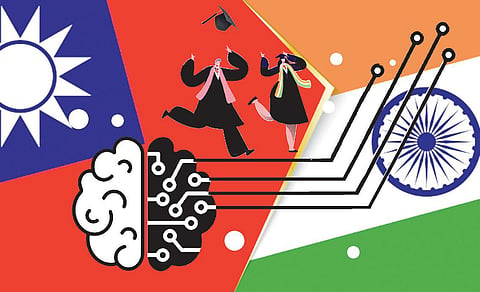

My lunch getting delayed due to potato chips which is on its way is ok. But the delay in the arrival of a huge consignment of workstations and computers, the delay in the delivery of a new SUV, delay in the arrival of electronic gadget for the virtual reality project, delay in PlayStations, washing machines and more such delays due to global shortage of chips of a different order is an issue of deep concern.
The global shortage of chips touching the supply chain of major industries has a concatenation effect that has been unprecedented. The geopolitical reasons apart, the impact of such shortages in the post-COVID recovery is of strategic importance as it may continue till 2023 going by the Intel CEO's recent comment.
Many countries have started their indigenous ways of handling the chip shortages with the US, Europe and China ramping up investments to reduce excessive dependence on East-Asian suppliers. India’s response is also beginning to trickle with its double-barrelled progressive initiatives.
Firstly, in a recent cabinet decision, a production-linked incentive (PLI) scheme for the semiconductor industry with an investment outlay of Rs 76,000 crore in the next five years has been announced by the Indian government.
The global semiconductor market valued at Rs 33 lakh crore in 2020 is expected to reach Rs 75 lakh crore by 2030. The Indian semiconductor market is also poised for a huge growth from its current level of Rs 1.13 lakh crore in 2020 to an estimated level of Rs 4.73 lakh crore by 2026 driven mainly by communication, automotive and consumer electronics.
Not only is the domestic market significant but also the geopolitical shift by various countries to look for alternate suppliers. The Indian response has in store a world of opportunities to ensure that we do not miss the hardware bus this time as we did in the 80s.
The time has come for India to take a quantum leap in the semiconductor manufacturing space as India’s Digital India and FAB India movement gains momentum. The National Electronics Policy 2019 envisages India to be a global hub for Electronics System Design and Manufacturing (ESDM) and enable the industry to compete globally.
The recent PLI approved by the cabinet is a step in that direction. With 75 percent of the global electronic manufacturing in East Asia, India’s strategic posturing with Taiwan is truly multi-dimensional.
Secondly, the Indo-Taiwan negotiations for a free trade agreement and setting up a semiconductor manufacturing facility in India may see Taiwan’s second manufacturing facility outside Taiwan, the first being in the USA. Taiwan Semiconductor Manufacturing Company (TSMC), which produces almost 50 percent of the world’s semiconductors presence in India, will be a boost for Indo-Taiwan relationship.
Though India and Taiwan don’t have diplomatic ties, the people to people and trade ties shall be a progressively binding factor. The dual effect of a possible Taiwanese and Indian semiconductor manufacturing facility in India means a lot for not only the global supply chain but also a call for capacity building to create employment for over 2,00,000 skilled people. The role of educational institutions across all levels is very important and more important is also the need to build Indo-Taiwan Educational alliance.
Facebook's Zuckerberg in a recent interview has acknowledged that India will hugely contribute in building Metaverse. Such is the capacity building that the Indian Software Services industry built in the last three decades, thanks to a multi-stakeholder response mechanism that involved the central and state governments, educational institutions, etc.
India's strength in semiconductor industry has been in FABless design with global majors already present in the country with their design centres. Can we afford to be designers just as we were developers in the software industry with very little product output?
The capacity building success story of the Indian software industry was predominantly scripted by the non-IITs which contributed the majority of the software services industry's workforce. The semiconductor industry workforce is a mixed bag ranging from specialised to basic engineering to technician to vocational. An Indo-Taiwan educational alliance across all levels in the next two to three years is the key to India’s hardware bus. With the signalling done, the policy vehicle needs to move.
(The writer is vice-chancellor of SASTRA-Deemed University and can be contacted via email at vaidhya@sastra.edu)